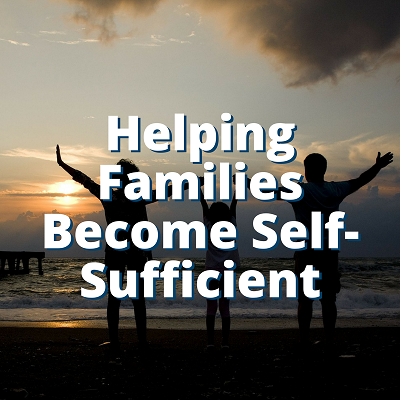Housing Support Programs Build Self-Sufficiency and Stability for Families

More than 1,000 people are homeless in San Luis Obispo County, according to a census conducted in January 2017. The County’s Housing Support Program is working to change that.
The program is a partnership between the County Department of Social Services and Family Care Network, Inc. and can best be described by the people who have benefited from it. One such person is Britney, whose last name we have omitted to protect her privacy.
In Britney's own words, here is her story:
“In my own experience, there wasn’t just one issue which resulted in me not having a home. A few years ago, I found myself in a rough position. The pressures of being a young, single mom were getting difficult to manage, and with the lack of affordable housing in my area, homelessness became a reality that I never anticipated. As a former foster youth, I didn’t have family with whom I could fall back on. But thankfully, the small support system I did have, allowed my children and I to camp in their backyard and in my car nearby when we no longer had a home. Our situation was very bleak, but then a county worker told me about HSP. Today, I consider myself one of the lucky ones. While my circle of support wasn’t large, it was just big enough to give me the support I needed to obtain housing in this insufficient and grossly competitive housing market. I’m thankful to report that my family is now housed and that I have not only completed the HSP program successfully, but I now get to support other families in their journeys towards self-sufficiency.”
The County's Housing Support Program utilizes a rapid rehousing model designed to end homelessness for CalWORKs families to enable them to achieve self-sufficiency, stability and safety. Since its inception in 2014, the program has permanently housed 273 families in San Luis Obispo County.
While there are many contributors to homelessness, a common theme among most families is a poor support system. The Housing Support Program fills that void while assisting with expenses related to housing search, credit repair, budgeting classes, tenancy education and housing case management. A housing navigator is available for housing search and landlord recruitment/landlord retention. Once a family finds an available rental, the program assists with move-in costs including security deposits, utility connection fees, basic furnishings and temporary monthly rental subsidies.
The County's newest rapid-rehousing program, called Bringing Families Home, mirrors the Housing Support Program while targeting families involved with Child Welfare Services. The goals of Bringing Families Home are to decrease the amount of time children spend in foster care, increase the number of families able to successfully reunify and provide short-term support to families after reunification to prevent reentry into the child welfare system. Bringing Families Home has permanently housed 12 families since the program began in June 2017.
With the hard work of County staff and community partners, the County strives to continue providing local families with the support and opportunities they need to reach self-sufficiency.
The program is a partnership between the County Department of Social Services and Family Care Network, Inc. and can best be described by the people who have benefited from it. One such person is Britney, whose last name we have omitted to protect her privacy.
In Britney's own words, here is her story:
“In my own experience, there wasn’t just one issue which resulted in me not having a home. A few years ago, I found myself in a rough position. The pressures of being a young, single mom were getting difficult to manage, and with the lack of affordable housing in my area, homelessness became a reality that I never anticipated. As a former foster youth, I didn’t have family with whom I could fall back on. But thankfully, the small support system I did have, allowed my children and I to camp in their backyard and in my car nearby when we no longer had a home. Our situation was very bleak, but then a county worker told me about HSP. Today, I consider myself one of the lucky ones. While my circle of support wasn’t large, it was just big enough to give me the support I needed to obtain housing in this insufficient and grossly competitive housing market. I’m thankful to report that my family is now housed and that I have not only completed the HSP program successfully, but I now get to support other families in their journeys towards self-sufficiency.”
The County's Housing Support Program utilizes a rapid rehousing model designed to end homelessness for CalWORKs families to enable them to achieve self-sufficiency, stability and safety. Since its inception in 2014, the program has permanently housed 273 families in San Luis Obispo County.
While there are many contributors to homelessness, a common theme among most families is a poor support system. The Housing Support Program fills that void while assisting with expenses related to housing search, credit repair, budgeting classes, tenancy education and housing case management. A housing navigator is available for housing search and landlord recruitment/landlord retention. Once a family finds an available rental, the program assists with move-in costs including security deposits, utility connection fees, basic furnishings and temporary monthly rental subsidies.
The County's newest rapid-rehousing program, called Bringing Families Home, mirrors the Housing Support Program while targeting families involved with Child Welfare Services. The goals of Bringing Families Home are to decrease the amount of time children spend in foster care, increase the number of families able to successfully reunify and provide short-term support to families after reunification to prevent reentry into the child welfare system. Bringing Families Home has permanently housed 12 families since the program began in June 2017.
With the hard work of County staff and community partners, the County strives to continue providing local families with the support and opportunities they need to reach self-sufficiency.
